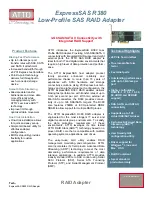
Administration: Discovery
Discovery - CDP
152
Cisco 350, 350X and 550X Series Managed Switches, Firmware Release 2.4, ver 0.4
9
•
CDP Frames Handling
—If CDP is not enabled, select the action to be taken if a packet
that matches the selected criteria is received:
-
Bridging
—Forward the packet based on the VLAN.
-
Filtering
—Delete the packet.
-
Flooding
—VLAN unaware flooding that forwards incoming CDP packets to all the
ports excluding the ingress ports.
•
CDP Voice VLAN Advertisement
—Select to enable the device to advertise the voice
VLAN in CDP on all of the ports that are CDP enabled, and are member of the voice
VLAN. The voice VLAN is configured in the
page.
•
CDP Mandatory TLVs Validation
—If selected, incoming CDP packets not
containing the mandatory TLVs are discarded and the invalid error counter is
incremented.
•
CDP Version
—Select the version of CDP to use.
•
CDP Hold Time
—Amount of time that CDP packets are held before the packets are
discarded, measured in multiples of the TLV Advertise Interval. For example, if the
TLV Advertise Interval is 30 seconds, and the Hold Multiplier is 4, then the LLDP
packets are discarded after 120 seconds. The following options are possible:
-
Use Default
—Use the default time (180 seconds)
-
User Defined
—Enter the time in seconds.
•
CDP Transmission Rate—
The rate in seconds at which CDP advertisement updates
are sent. The following options are possible:
-
Use Default
—Use the default rate (60 seconds)
-
User Defined
—Enter the rate in seconds.
•
Device ID Format
—Select the format of the device ID (MAC address or serial
number). The following options are possible:
-
MAC Address
—Use the MAC address of the device as the device ID.
-
Serial Number
—Use the serial number of the device as the device ID.
-
Hostname
—Use the host name of the device as the device ID.
•
Source Interface
—IP address to be used in the TLV of the frames. The following
options are possible:
-
Use Default
—Use the IP address of the outgoing interface.
















































